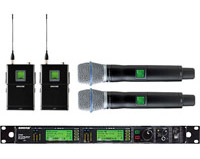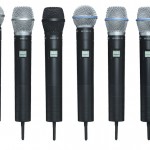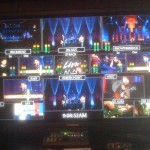
You Always Need a Plan – 2009 RF Part 2

When I last left off, Jayce, Michael, and I had gotten together to discuss the loss of the 700 MHz band for wireless use. Out of our discussion we came up with an idea that we were all pretty excited about. The plan was to upgrade the main auditoriums, the Attic, and the Theatre to a consistent wireless system while relocating our existing safe RF mics to our other environments currently using 700 MHz microphones.
With wireless purchases in the past, the tendency has been to equip an environment with a bodypack and a handheld for each receiver to allow for maximum flexibility in programming. This has been great to have, but the reality is that none of our main environments really need that much flexibility. We decided it would be better stewardship in today’s present reality to reduce flexibility within one environment while increasing flexibility across our environments by unifying the receivers in each room. Basically we want to move towards more gear sharing than creating production islands. Here’s an example of how this could go play out. KidStuf uses a lot of bodypacks while the Attic doesn’t. Should the Attic get in a pinch for bodypacks, they can head over to the Theatre and borrow some. If the theatre needs more handhelds, we’ve probably got a couple in our auditorium that we can spare.
Some of you are probably wondering what we’d like to get for our unified system, and that would be Shure UHF-R’s. There are a lot of great systems out there these days, but the UHF-R’s make the most sense for us. We’re currently a large Shure user so we’re all very familiar with their products. My system that will be replaced is the Shure UHF system which is the UHF-R’s predecessor and some of our existing components are compatible with the new stuff. Plus I know that they sound great after doing our little mic shootout earlier this year.
However, even with a plan for what we wanted, there was still a lot to be done. The first thing I needed to do was organize the relocation of our existing RF mics. This would serve two purposes. For starters it would be part of the solution we proposed to the decision makers above us. Secondly, we needed an organized list of what we were going to continue to use so that we re-coordinate frequencies for the entire campus.
Given the scope of the RF situation in our room, I knew I should get some outside help on this from an expert. I contacted Clark ProMedia who have been helping me with my audio needs for somewhere around 4 years now, and they brought in Luis Guerra from Shure to help navigate the crowded frequency spectrum and make sure we would get the right gear we needed. Luis filled in some of the gaps in my knowledge about what was happening while also assuring me that there would be enough room for everything we wanted to do. This is thanks in part to the analog TV stations that will disappear in February of 2009.
I’ve spent the last couple of weeks nailing down our final equipment list. We were originally hoping to get all of our UHF-R’s within the same band to allow for maximum flexibility on our campus, but unfortunately we have had to split things up into two bands, G1 & H4. The G1 is the favored band for us because it’s where the FCC is going to set aside some room for wireless mics. H4 is where I feel like we could have the most potential interference in the future and need to move frequencies around.
I’ve spent a lot of time going over and revising the room distribution plan from Shure to make sure that our priority mics land in the G1 band in each room while also trying to get a balance so that we can have flexibility to swap transmitters between rooms when we need to. This is all complicated by the different quantities of channels each room is getting and the varying needs. For example, the Attic will have all their mics in G1 because they aren’t a heavy RF user. Meanwhile KidStuf and the auditoriums will get a mix of G1 and H4. If we put all our bodypacks in H4, the Attic won’t be able to use them so we need to get those mixed into G1. If the theatre has most of their bodypacks in G1, and they need an extra handheld where will they put it? They’ll probably be using all their G1 channels so they’ll need an H4 handheld which would come from my room. Will I have an extra in H4 to give or will those most likely be the ones we’re using? There is no perfect solution.
At any rate, I feel like I’ve finally got everything equipment wise in a good place. I dumped our prospective 2009 RF equipment into my intermod software from Professional Wireless the other day. A rough coordination using prospective digital TV stations in 2009 gave me the best results I’ve ever had using the software with only a couple of intercom devices potentially problematic. I feel very good knowing this is probably going to be a better setup than we’re currently using every week.
But even with the equipment side sorted, there’s still a good amount of work to do. The next big thing I need to figure out is an implementation plan. We’re going to do a new coordination for the entire site so the entire campus is going to need to turn over within a week. That means there will be a lot of existing gear getting reprogrammed along with all the new gear coming online all at the same time. It’s going to be big and unfortunately we might need to wait until the analog TV stations disappear on February 9th. I’m going to talk to Luis and get a plan formulated with him for implementing everything.

 Previous Post
Previous Post Next Post
Next Post



Great news… The UHF R’s are great. I have been traveling with the R’s since they came out in late 05 and have never had any problems with them. The new sennheiser 3732 is awesome also, but for the price difference I would agree that the Shure UHF R is the way to go. With the Wireless Workbench software you can keep an eye on your RF environment from FOH and it also interfaces with the Winradio G3 series of scanners so you don’t have to tie up a receiver for scanning. Hopefully once you program, you won’t have to do it again. With the research you have done in IAS, you should be really close. The program is usually spot on. We’ll see what changes in the next IAS FCC update in feb.
By the way… did you ever say which mics won the shootout? What capsules will you be choosing for all those nifty new transmitters? Also, just curious… when you do need a lav, what do you usually go with?
Bill, the problem with the mic shootout is nobody won. Everything sounded great so in the end it all comes down to different tastes. Browns Bridge loves the KSM9. We love the Neumann capsules as does Buckhead. My biggest surprise from the shootout was how good a straight up 58 can sound on a great singer with a great delivery system, and I’ve hated 58’s for the last couple years right up until we swapped our drivers out.
For the new system we’re getting a mix of KSM9, Beta58, and SM58 capsules. I think that’s going to serve us well for a bit. We have some existing Beta58’s and Beta87’s we’ll pull off our UHF stuff to add to our collection, but I think my go-to’s with the new stuff will be the KSM9 and 58. I also have no intention of retiring our 5000 series Sennheiser handheld with a KK104 capsule, and I’m hoping to get a twin to go with it because I have a couple of singers that thing is money on.
As for “lavs”, I don’t use real lavs. Seriously, I don’t. I haven’t used one since I got down to Atlanta. There might be a couple somewhere in our amp room, but they just don’t get used. Now, we do use headworn mic’s in what was a typical lav capacity, and for those I lean towards the Countryman E6–NOT the E6i. The DPA 4066’s are good, too, but I like the E6 a little more probably just from my own history of using them. It doesn’t hurt that I’ve got a subgroup with an EQ optimized for an E6 in my room, either.
I use an E6i. What’s the difference? For one, I know that the padding around the ear is larger, which is equal parts comfortable and annoying…
The E6i is more flexible so it can be harder to get to stay still and in position.
This actually brings up a good point with the E6. They are not the easiest mics to get positioned. If you get too close to a mouth or a nose, you can easily get a lot of popping. In contrast, the headworn mics with a band around the back of the head–in my experience–tend to be a little easier to position and it’s also easier to repeat the positioning.
So no difference sonically? (Unless you count bad positioning leading to sonic difficulties.)
No difference. The element is the same. I remember talking to Carl Countryman at NAB right before the E6i came out. It was designed in response to folks who have a hard time shaping the E6 or who feel uncomfortable reshaping the E6.
Did you try the Sabine wireless product? I was doing consulting for them in 2000 when that product was being formulated, and I never got to see the final results. The “WiFi ring of death” for testing was pretty impressive, though…